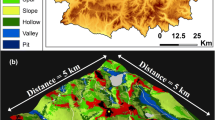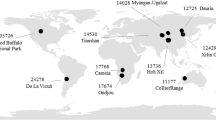Abstract
The diversity of future landscapes might depend on our ability to predict their potential species richness. The predictability of patterns of vascular plant species richness in a Finnish agricultural river landscape was studied using generalized linear modeling, floristic records from fifty-three0.25-km grid squares in the “core” study area, and environmental variables derived from Landsat TM images and a digital elevation model. We built multiple regression models for the total number of plant species and the number of rarities, and validated the accuracy of the derived models with a test set of 52 grid squares. We tentatively extrapolated the models from the core study area to the whole study area of 601 km2 and produced species richness probability maps using GIS techniques. The results suggest that the local ‘hotspots’ of total flora (grid squares with > 200species) are mainly found in river valleys, where habitat diversity is high and a semi-open agricultural-forest mosaic occurs. The ‘hotspots’ of rare species (grid squares with > 4 rare species) are also found in river valleys, in sites where extensive semi-natural grasslands and herb-rich deciduous forests occur on steep slopes. We conclude that environmental variables derived from satellite images and topographic data can be used as approximate surrogates of plant species diversity in agricultural landscapes. Modeling of biological diversity based on satellite images and GIS can provide useful information needed in land use planning. However, due to the potential pitfalls in processing satellite imagery and model-building procedures, the results of predictive models should be carefully interpreted.
Similar content being viewed by others
References
Augustin N.H., Mugglestone M.A. and Buckland S.T. 1996. An autologistic model for spatial distribution of wildlife. Journal of Applied Ecology 33: 339-347.
Austin M.P. 1999. The potential contribution of vegetation ecology to biodiversity research. Ecography 22: 465-485.
Austin M.P., Cunningham R.B. and Fleming P.M. 1984. New approaches to direct gradient analysis using environmental scalars and statistical curve-fitting procedures. Vegetatio 55: 11-27.
Austin M.P., Pausas J. and Nicholls A.O. 1996. Patterns of tree species richness in relation to environment in south-eastern New South Wales Australia. Australian Journal of Ecology 21: 154-164.
Austin M.P. and Heyligers P.C. 1991. New approach to vegetation survey design: gradsect sampling. In: Margules C.R. and Austin M.P. (eds), Nature Conservation: Cost Effective Biological Surveys and Data Analysis. CSIRO, Australia, pp. 31-36.
Birks H.J.B. 1996. Statistical approaches to interpreting diversity patterns in the Norwegian mountain flora. Ecography 19: 332-340.
Burrough P.A. and McDonnell R.A. 1998. Principles of Geographical Information Systems. Spatial Information Systems, lOxford University Press, New york, 333 p.
Bustamante J. 1997. Predictive models for Lesser Kestrel Falco naumanni distribution, abundance and extinction in southern Spain. Biological Conservation 80: 153-160.
Cherril A.J., McClean C., Watson P., Tucker K., Rushton S.P. and Sanderson R. 1995. Predicting the distributions of plant species at the regional scale: hierarchical matrix model. Landscape Ecology 4: 197-207.
Finnish Meteorological Institute 1991. Climatological Statistics in Finland 1961-1990. Supplement of Meteorological Yearbook of Finland., Helsinki.
Cortijo F.J. and Perez de la Blanca N. 1998. Improving classical contextual classifications. International Journal of Remote Sensing 19: 1591-1613.
Cracknell A.P. 1998. Synergy in remote sensing -What's in a pixel? International Journal of Remote Sensing 19: 2025-2047.
Crawley M.J. 1993. Glim for Ecologists. Blackwell Scientific Publications, Oxford, 379 pp.
Currie D.J. 1991. Energy and large-scale patterns of animal-and plant-species richness. American Naturalist 137: 27-49.
Debinski K., Kindscher D.M. and Jakubauskas M.E. 1999. A remote sensing and GIS-based model of habitats and biodiversity in the Greater Yellowstone Ecosystem. International Journal of Remote Sensing 17: 3281-3291.
Esseen P.-A., Ehnström B., Ericson L. and Sjöberg K. 1992. Boreal forests-the focal habitats of Fennoscandia. In: Hansson L. (ed.), Ecological Principles of Nature Conservation. Elsevier, London, pp. 254-325.
Eurola S., Hicks S. and Kaakinen E. 1984. Key to finnish mire types. In: Moore P.D. (ed.), European Mires. Academic Press, London, pp. 11-117.
Eyre M.D. and Rushton S.P. 1989. Quantification of conservation criteria using invertebrates. Journal of Applied Ecology 26: 159-171.
Flack V.F. and Chang P.C. 1987. Frequency of selecting noise variables in subset regression analysis: a simulation study. The American Statistician 41: 84-86.
Fisher P. 1997. The pixel: a snare and a delusion. International Journal of Remote Sensing 18: 679-685.
Gaston K.J. 1994. Rarity. Chapman & Hall, London, 205 pp.
Gaston K.J. 1996. Species richness: measure and measurement. In: Gaston K.J. (ed.), Biodiversity. A Biology of Numbers and Difference. Blackwell Science, Oxford, pp. 77-113.
Griffiths G.H., Smith J.M., Veitch N. and Aspinall R. 1993. The ecological interpretation of satellite imagery with special reference to bird habitats. In: Young R.H., Green D.R. and Cousins S.H. (eds), Landscape Ecology and Geographic Information Systems. Taylor & Francis Ltd, London, pp. 255-272.
Griffiths G.H. and Mather P.M. 2000. Remote sensing and landscape ecology: patterns and landscape change. International Journal of Remote Sensing 21: 2537-2540.
Hämet-Ahti L., Suominen J., Ulvinen T., Uotila P. and Vuokko S. 1986. Retkeilykasvio (Field Flora of Finland). Suomen Luonnonsuojelun Tuki Oy., Helsinki, 598 pp.
Heikkinen R.K. 1996. Predicting patterns of vascular plant species richness with composite variables: a meso-scale study in Finnish Lapland. Vegetatio 126: 151-165.
Hill N.M. and Keddy P.A. 1992. Prediction of rarities from habitat variables: coastal plain plants on Nova Scotian lakeshores. Ecology 73: 1852-1859.
Holmes K.W., Chadwick O.A. and Kyriakidis P.C. 2000. Error in a USGS 30-meter digital elevation model and its impact on terrain modeling. Journal of Hydrology 233: 154-173.
Hörnberg G., Zackrisson O., Segerström U., Svensson B.W., Ohlson M. and Bradshaw H.W. 1998. Boreal swamp forests. Biodiversity “hotspots” in an impoverished forest landscape. BioScience 48: 795-802.
Iverson L.R., Dale M.E., Scott C.T. and Prasad A. 1997. A GISderived integrated moisture index to predict forest composition and productivity of Ohio forests (U.S.A.). Landscape Ecology 12: 331-348.
James F.C. and McCulloch C.E. 1990. Multivariate analysis in ecology and systematics: Panacea or Pandora's box? Annual Review of Ecology and Systematics 21: 129-166.
Kohn D.D. and Walsh D.M. 1994. Plant species richness-the effect of island size and habitat diversity. Journal of Ecology 82: 367-377.
Kontula T., Lehtomaa L. and Pykälä J. 2000. Land use history vegetation and flora in Rekijoki valley Somero SW Finland. Finnish Environment 306: 1-96.
Kotiranta H., Uotila P., Sulkava S. and Peltonen S.-L. 1998. Red Data Book of East Fennoscandia. Ministry of the Environment, Finnish Environment Institute, Finnish Botanical Museum, Finnish Museum of Natural History, Helsinki, 351 pp.
Lehtomaa L. 2000. Rural biotopes of SW Finland. Regional environmental series 160. Southwest Finland Regional Environment Centre, Turku.
Lillesand T.M. and Kiefer R.W. 1994. Remote Sensing and Image Interpretation. John Wiley & Sons. Inc., USA, 650 pp.
Luoto M. 2000. Modelling of rare plant species richness by landscape variables in an agriculture area in Finland. Plant Ecology 149: 157-168.
Mac Nally R. 2000. Regression and model-building in conservation biology, biogeography and ecology: The distinction between-and reconciliation of-‘predictive’ and ‘explanatory’ models. Biodiversity and Conservation 9: 655-671.
Margules C.R. and Austin M.P. 1991. Nature Conservation: Cost effective biological surveys and data analysis. CSIRO, Australia, 207 pp.
Margules C.R., Nicholls A.O. and Austin M.P. 1987. Diversity of Eucalyptus species predicted by a multivariable environmental gradient. Oecologia 71: 229-232.
McCullagh P. and Nelder J.A. 1989. Generalized Linear Models. Chapman & Hall, London, 511 pp.
McGarical K. and Marks B.J. 1994. Fragstats Spatial Pattern Analysis Program for Quantifying Landscape Structure Version 2.0.Forest Science Department, Oregon State University, Corvallis, Oregon, USA, 67 pp.
McIntyre S. and Lavorel S. 1994. Predicting richness of native rare and exotic plants in response to habitat and disturbance variables across a variegated landscape. Conservation Biology 8: 521-531.
Miller R.I. 1986. Predicting rare plant distribution patterns in the southern Appalachians of the south-eastern U.S.A. Journal of Biogeography 13: 293-311.
Nagendra H. and Gadgil M. 1999. Satellite imagery as a tool for monitoring species diversity: an assessment. Journal of Applied Ecology 36: 388-397.
Nicholls A.O. 1991. Examples of the use of Generalized linear models in analysis of survey data for conservation evaluation. In: Margules C.R. and Austin M.P. (eds), Nature Conservation: Cost Effective Biological Surveys and Data Analysis. CSIRO, Australia, pp. 54-63.
Nilsson C., Grelsson G., Johansson M. and Sperens U. 1988. Can rarity and diversity be predicted in vegetation along river banks? Biological Conservation 44: 201-212.
Payne C.D. 1986. The GLIM System Release 3.77 Manual. Numerical Algorithms Group, Royal Statistical Society.
Philippi T.E. 1993. Multiple regression: Herbivory. In: Schneider S.M. and Gurevitch J. (eds), Design and Analysis of Ecological Experiments. Chapman & Hall, New York, pp. 183-210.
Prendergast J.R., Quinn R.M., Lawton J.H., Eversham B.C. and Gibbons D.W. 1993. Rare species, the coincidence of diversity hotspots and conservation strategies. Nature 365: 335-337.
Pykälä J. and Lappalainen I. 1998. Nykyaika näkyy maatalousympäristöissä. In: Lappalainen I. (ed.), Suomen luonnon monimuotoisuus (Biodiversity of Finland). Finnish Environment Institute, Helsinki, pp. 184-195.
Rassi P., Kaipiainen H., Mannerkoski I. and Ståhls G. 1992. Uhanalaisten eläinten ja kasvien seurantatoimikunnan mietintö (English abstract: report on the monitoring of threatened animals and plants in Finland). Ministry of Environment, Helsinki.
Richards J.A. 1996. Classifier performance and map accuracy. Remote Sensing Environment 57: 1616-166.
Richerson P.J. and Kwei-Lin L. 1980. Patterns of plant species diversity in California: relation to weather and topography. American Naturalist 116: 504-536.
Rossi E. and Kuitunen M. 1996. Ranking of habitats for the assessment of ecological impact in land use planning. Biological Conservation 77: 227-234.
Scott J.M., Davis F., Csuti B., Noss R., Butterfield B., Groves C. et al. 1993. Gap analysis: a geographic approach to protection of biological diversity. Wildlife Monographs 57: 1-41.
Spellerberg I.F. 1992. Evaluation and Assessment for Conservation. Chapman & Hall, London, 260 pp.
Stoms D.M. 1992. Effects of Habitat Map Generalization in Biodiversity Assessment. Photogrammetric Engineering and Remote Sensing 58: 1587-1591.
Stoms D.M. and Estes J.E. 1993. A remote sensing research agenda for mapping and monitoring biodiversity. International Journal of Remote Sensing 10: 1839-1860.
Stoutjesdijk Ph. and Barkman J.J. 1992. Microclimate Vegetation and Fauna. OPULUS Press AB, Knivsta, Sweden, 216 pp.
Tonteri T. 1994. Species richness of boreal understorey forest vegetation in relation to site type and successional factors. Annales Zoologici Fennici 31: 53-50.
Turner M.G. 1989. Landscape Ecology: The Effect of Pattern on Process. Annual Review of Ecology and Systematics 20: 171-197.
Urban D.L., O'Neill R.V.O. and Shugart H.H. 1987. Landscape ecology: a hierarchical perspective can help scientist understand spatial patterns. BioScience 37: 119-127.
Vande Castle J. 1998. Remote sensing applications in Ecosystem Analysis. In: Peterson D.L. and Parker V.T. (eds), Ecological Scale-Theory and Applications. Columbia University Press, New York.
Walker P.A. 1990. Modelling wildlife distribution using a geographic information system: kangaroos in relation to climate. Journal of Biogeography 17: 279-289.
Whittaker R.H. 1956. Vegetation of the Great Smoky Mountains. Ecological Monographs 26: 1-80.
Wiens J.A. 1986. Spatial scale and temporal variation in studies of shrubsteppe birds. In: Diamond J. and Case T.J. (eds), Community Ecology. Harper & Row Publishers, New York, pp. 154-172.
Wohlgemuth T. 1996. Modelling floristic species richness on a regional scale: a case study in Switzerland. Biodiversity and Conservation 7: 159-177.
Yee T.W. and Mitchell N.D. 1991. Generalized additive models in plant ecology. Journal of Vegetation Science 2: 587-602.
Author information
Authors and Affiliations
Rights and permissions
About this article
Cite this article
Luoto, M., Toivonen, T. & Heikkinen, R.K. Prediction of total and rare plant species richness in agricultural landscapes from satellite images and topographic data. Landscape Ecology 17, 195–217 (2002). https://doi.org/10.1023/A:1020288509837
Issue Date:
DOI: https://doi.org/10.1023/A:1020288509837




